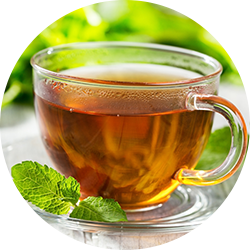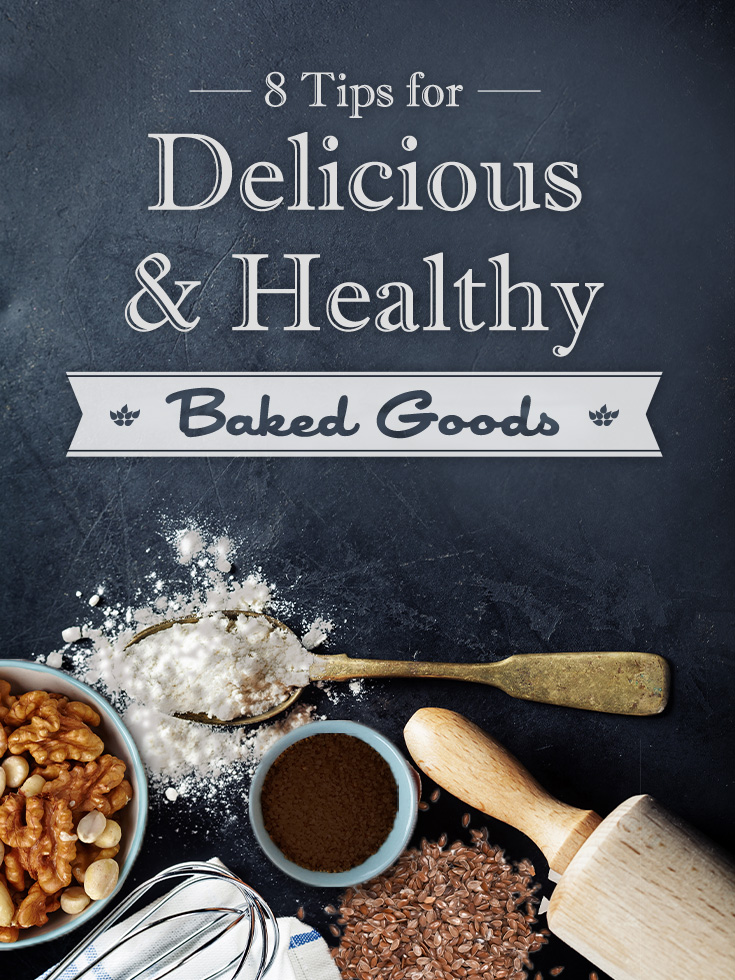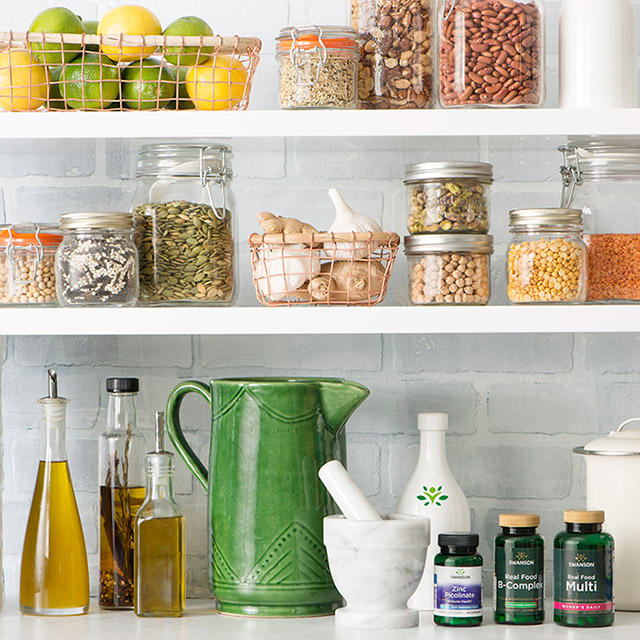18 Food Replacement Hacks that Make Healthy Eating Easy
Food Replacement Hacks for Better Health
Eating healthfully at every single meal can be a challenge, but simply replacing some of your usual pantry staples with healthier options can help in a really big way!
When we’re hungry, we tend to reach for what’s on hand. And by keeping healthy food swaps around, we set ourselves up for nutritional success.
That doesn’t mean you need to sacrifice flavor. Some of these healthy swaps are even more delicious and flavorful than what they’ve replaced!
It also doesn’t mean you need to eliminate certain foods from your diet altogether. The point is to balance your diet and reach for nutritious options more often, building better habits that lead to a healthier you along the way.
Here are 18 food replacement hacks that make healthy eating easy.
1. Replace White Rice with Quinoa
White rice isn’t necessarily bad for you, but it is higher in calories and carbs than quinoa, plus quinoa will give you an extra boost of fiber, protein and minerals like iron and zinc.1
Despite its grain-like qualities, quinoa is actually a seed from a plant known as goosefoot, which is in the same family as spinach and beets.1
It makes a truly delicious and nutritious superfood substitute for rice and works well in so many recipes. Quinoa offers 8 g of protein per cooked 8 oz cup. It’s high in fiber, with 5 g of fiber per cup, and it’s a source of iron, magnesium, phosphorus, manganese and zinc.1
Give it a try in this delicious recipe for Quinoa Meatballs, or Slow Cooker Vegetarian Quinoa Soup.
2. Replace Vegetable Oil or Butter with Coconut Oil
Coconut oil contains medium-chain triglycerides (MCTs) which metabolize quickly for fast energy.2 It’s great for sautéing veggies and cooking at high temperatures.
You can also spread it on toast instead of butter, use it to pop popcorn, add it to smoothies and try it in keto coffee recipes.
As with any fat or oil, keep an eye on your total calorie intake, but if you’re simply replacing your usual cooking oil with coconut oil, you shouldn’t notice a big difference in calorie content. Most oils and fats have between 100-140 calories per tablespoon.3
3. Replace Sour Cream with Greek Yogurt
We aren’t kidding! Surprisingly, you probably won't be able to tell that you just put greek yogurt on your taco instead of sour cream.
Just make sure you get the plain kind instead of flavored. You can even jazz it up with some lemon and hot sauce.
What’s the benefit? Greek yogurt is high in protein and even contains probiotics, which support healthy digestion and immune health.4
4. Replace Potato Chips with Popcorn
A 28 g serving of classic potato chips contains 160 calories, 10 g of fat and 15 g of carbohydrates.12 And that's just for a standard 1 oz bag size. How many people actually count their chips out of a larger bag?
You could eat 4.5 cups of air-popped popcorn and still consume fewer calories than in a single serving of chips.
Air-popped popcorn contains only 31 calories per cup! Plus, you get more fiber and protein from popcorn, and you can customize the flavor with your own seasoning.
5. Replace Croutons with Almonds
Who doesn’t love a little crunch in their salad? Croutons definitely give us that, but not much else.
Almonds, however, pack in the nutrition with 13 vitamins and minerals including potassium, magnesium, calcium and vitamin E, plus fiber and protein!
So, the next time you want to add a little crunch to your salad, make it count! Add an ounce of delicious almonds instead of stale bread.
You can flavor your almonds by tossing them in your favorite seasonings before adding them to your salad.
6. Replace Flour with Coconut Flour
Even if you aren’t going gluten-free, wheat flour alternatives have a lot to offer, and coconut flour is one of our favorite flour alternatives. It’s made from dried and finely ground coconut meat.
Coconut flour has fewer carbs than other nut flours and 11 times as much fiber as wheat flour, plus more protein.13 Its light, airy texture makes it great for baking and especially good for pastries.
7. Replace Sugar with Stevia
Stevia isn’t just another artificial sweetener. It’s a plant!
Stevia has been used to make beverages sweeter since the 16th century and its leaves were even made into a tea.5
Stevia is 200 to 300 times sweeter than regular sugar, so a little goes a long way, and it’s practically calorie-free.5
Use it to sweeten your coffee, tea, oatmeal, or anything else you’d normally sweeten with granulated sugar. Just be careful with how much you add until you get used to the sweetness level. It doesn’t take much!
The perfect herbal alternative to sugar, you can even find it in liquid form!
8. Replace Table Salt with Himalayan Salt
Pink Himalayan salt is rock salt mined near the Himalayas from an ancient seabed.6
Like table salt, pink Himalayan salt primarily consists of sodium chloride, but it also contains small amounts of 84 additional trace elements and minerals.
Himalayan salt has larger crystals and contains less sodium per teaspoon than table salt, and it has a saltier taste, so you'll probably need less of it than regular salt.6
Himalayan salt also doesn’t undergo the heavy processing that most standard table salts endure.6
Give Himalayan crystal salt a try and see for yourself. You’ll probably never want to go back to regular salt again!
9. Replace Breadcrumbs with Chia Seeds
Chia seeds make an excellent swap for breadcrumbs in recipes like meatballs or meatloaf that need a little help sticking together. These superfood seeds can absorb up to 27 times their weight in water!7
You can also use them as breading, either whole or ground, with or without mixing them with other ingredients.
We love mixing chia seeds with shredded coconut or chopped nuts to use as a breading for oven-baked chicken or fish.
Chia seeds are packed with omega-3 fatty acids, antioxidants, fiber, iron and calcium, and they even contain protein.7
And breading isn’t the only way to use them: chia seeds make a great mix-in for smoothies too!
Chia seeds are available in both black and white variations, but there are no nutritional differences between the two. Feel free to mix them together to add a little flair to your recipes.
10. Replace Chocolate Chips with Cocoa Nibs
Replace your processed, sugary chocolate chips with cocoa nibs (chocolate in its purest form) for a healthier alternative. The deep flavor of cocoa nibs adds complexity and irresistible chocolate flavor to your baked goods, trail mixes, smoothies and more. You can also snack on them straight out of the bag!
Cocoa nibs aren’t just a delicious treat; they’re nutritional powerhouses too! They’re a source of antioxidants, fiber, iron and magnesium, and they may even boost your mood and enhance cognitive performance!8
11. Replace Iceberg with Romaine
Leafy salad greens are all low in calories, but some of them have more to offer when it comes to nutrition. Romaine beats out iceberg in the nutritional battle every time.
Romaine lettuce is rich in carotenoid vitamin A, packing in 11 times more than iceberg.9 Romaine is also a better source of vitamin K, and contains more than five times the amount of vision-supporting antioxidants lutein and zeaxanthin than iceberg.9
12. Replace Ranch Dressing with Olive Oil + Vinegar
Have you read the ingredients list on the back of a bottle of ranch dressing? Most types of ranch dressing contain more than 20 ingredients and preservatives, many of which most of us can’t even pronounce.
It gets even more complicated with low fat and fat-free options that contain artificial sweeteners.
Why not keep it simple, healthier and flavorful with olive oil and balsamic vinegar salad dressing instead? You can also add fresh herbs like garlic and parsley for a flavor boost.
13. Replace Mayo with Mustard
This food replacement hack doesn’t work in every recipe, but mayo is notoriously high in fat and calories. When you can make another condiment choice, it’s a good idea to do so.
Mustard is super low in calories and offers tons of flavor, and there are plenty of delicious options to try, from organic dijon mustard to honey & dill flavored mustard and more!
14. Swap Processed Peanut Butter with Unprocessed Almond Butter
Although they are similar in calorie count, processed peanut butter contains hydrogenated vegetable oils and added sugars.
Even when you consider all natural, unprocessed peanut butter, almond butter still wins on the nutritional front.
Swap out this old pantry staple for almond butter and get more vitamins and minerals, less saturated fat, more fiber and less sugar per serving.
15. Replace Milk with Almond Milk
Plant-based milks are trending, and there’s no shortage of options, from oat milk to rice milk, cashew milk and beyond.
But the deliciously mild, nutty flavor and creamy texture of almond milk has kept it a favorite.
Unsweetened almond milk is lower in calories and contains no cholesterol, saturated fat, or lactose. Unlike cow’s milk, almond milk does not contain calcium unless it’s enriched, so make sure to get your calcium from other sources if you make the swap from cow’s milk to almond milk.
One of our favorite perks of switching to almond milk, aside from the flavor and calorie reduction, is that it’s so easy to make at home.
If you keep a stash of almonds on hand, you’ll never run out of milk because you can make another batch with just a couple of ingredients and water.
Here’s a great recipe:
Almond Milk Recipe10
-
- 1 cup of raw almonds (soaked overnight in cool water or 1-2 hours in very hot water)
- 5 cups filtered water (or less depending on how thick you want your milk)
- pinch of Himalayan sea salt
Optional add-ins:
-
- 2 pitted dates or other sweetener (for sweetened almond milk)
- 1 tsp of vanilla extract or one scraped vanilla bean (for vanilla almond milk)
- 2 tbsp of cocoa powder (for chocolate almond milk)
- 1/2 cup of berries (for berry-flavored almond milk)
How to make it:
-
- Drain soaked almonds and add them to a blender with filtered water, salt and your optional add-ins.
- Strain using a nut milk bag or thin dish towel.
- Refrigerate in a covered bottle & shake well before drinking.
16. Replace Soda with Tea
You probably have a hunch that soda isn’t the best beverage choice you could make, but do you know why? Regular soda contains 37 g of sugar and 155 calories per 12 oz serving, plus has little nutritional value to offer. And diet sodas aren’t any better!
Reports have linked soda consumption with everything from unhealthy teeth & bones to weight gain and heart health concerns.11
So, the next time you think about reaching for a soda, opt for antioxidant-packed tea instead.
Tea comes in practically endless flavors and varieties, so you’ll never get bored. You can drink it hot or iced and sweetened, and you can keep both caffeinated and decaf herbal teas on hand for any time of day or night.
Try brewing up some chai tea and adding a splash of almond milk and stevia for a delicious dessert-like treat!
17. Replace Sports Drinks with Coconut Water
Speaking of sugary drinks, sports drinks are a major offender. Staying hydrated during physical activity is important, but you can do it better without the 34 g of sugar in a bottle of the leading sports drink.
Coconut water is mother nature’s sports drink. A cup of coconut water boasts 600 mg of the electrolyte potassium, plus magnesium, calcium, phosphorus, and naturally-occurring sodium, which are all electrolytes.14
Coconut water contains several other nutrients and only 6 g of sugar. It’s naturally sweet and refreshing, so stock up on coconut water for a healthier way to hydrate and replenish electrolytes.
18. Replace Fruit Juice with Fruit-Infused Water
Fruit juice has its perks, and we aren’t saying you should stay away from juice altogether. But if you’re watching your sugar and calorie intakes, you’ll want to keep an eye on how much fruit juice you consume each day.
In fact, you would be better off eating the fruit whole than drinking the juice because you’ll get more fiber and other nutrients that way.
As far as fruity beverages go, try swapping your fruit juice with fruit-infused water. You’ll get the irresistible flavors of your favorite fruits without the calories and sugar in juice, and it’s so easy to make at home. Read Water for the Win: Benefits of Water, Plus 5 Water Infusions to Try for some great ideas.
Healthier Food Swaps Make a Difference
You don’t need to change your diet all at once to eat healthier. Starting with small changes like these healthier food swaps, you can make better choices and create healthy habits every day that bring you closer to your nutritional and wellness goals.

About Lindsey Toth, MS, RD
Registered Dietitian, Swanson Health
Lindsey is a nationally recognized registered dietitian and nutritionist with a soft spot for ice cream. She empowers people to take charge of their health by finding the balance between the pleasure and nourishment in food.
Her philosophy is that you should take care of your body because it’s the only permanent home you have. It’s what inspired her to pursue a career in nutrition and, ultimately, led her to Swanson Health.
*These statements have not been evaluated by the Food and Drug Administration. These products are not intended to diagnose, treat, cure, or prevent any disease.
Sources
1. Quinoa vs. Rice. Healthline. Read source
2. MCT Oil 101. Healthline. Read source
3. Oils & Fats. Read source
4. The Health Benefits of Greek Yogurt. U.S News & World Report. Read source
5. What is Stevia? Medical News Today. Read source
6. Health Benefits of Pink Himalayan Salt. Medical News Today. Read source
7. Health Benefits of Chia Seeds. Medical News Today. Read source
8. Cocoa Flavonol. National Library of Medicine. Read source
9. The Nutritional Value Of Lettuce. Medical Daily. Read source
10. How to Make Almond Milk. Recipe adapted from Minimalist Baker. Read source
11. Stop Drinking Soda. CNN Health. Read source
12. Potato Chips Info. Carb Manager. Read source
13. Coconut Flour. Healthline. Read source
14. Coconut Water. Mayo Clinic. Read source




